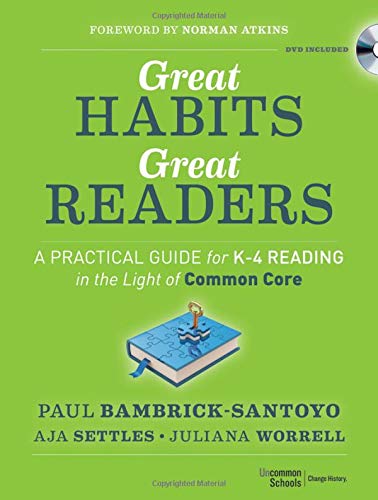Great Habits, Great Readers: A Practical Guide for K - 4 Reading in the Light of Common Core / Paul Bambrick-Santoyo, Aja Settles, Juliana Worrell
| List Price: | |
Our Price: $17.97 | |
|
For Bulk orders
| |
|
Used Book Price: $0.16 | |
| Great Habits, Great Readers: A Practical Guide for K - 4 Reading in the Light of Common Core / Paul Bambrick-Santoyo, Aja Settles, Juliana Worrell | |
| Publisher: Jossey-Bass | |
| Availability:Usually ships in 24 hours | |
| Sales Rank: 275708 | |
|
Similar Books
Top 4 Tips for K-4 Reading Teachers
1. Habits begin at the moment of error, not the moment of success. Address student error when it happens, and you create opportunities for students to practice the right habits instead of the wrong ones.
2. Change how students talk about reading and you’ll change how they think about reading. Authentic literary discussions give students unequalled opportunities to do the heavy cognitive work of reading—and they’re possible even for our youngest students.
3. Students can’t fall in love with reading if they aren’t reading to begin with. Consequently, independent reading—a sustained block of time that all students spend reading on their own—is integral to the success of any reading program.
4. The Common Core asks us to accelerate our instruction. Our students need us to meet them where they are. With the right tools in hand, you can do both. Exemplary guided reading instruction will allow you to teach a continuum of skills while tailoring your instruction in those skills to the developmental needs of each child.
Q&A With the Authors
Let’s start with the big question: How will Great Habits, Great Readers help teachers prepare students for Common Core-level rigor?
That word “rigor” is really the key. As educators, we all want our students to be able to thrive in a rigorous learning environment where they-- not we--do the heavy cognitive work. And the Common Core standards only take us halfway to that goal. They’re a big step towards rigor, because they require students to master more complex skills by younger grades than ever before. But whether we actually reach rigor still depends on how we measure those standards. For example, the Common Core says third graders need to know how to identify character traits. But the third-grade teacher who asks “Did the brother really mean it when he said he was okay?” isn’t giving her students such rigorous instruction as the teacher who asks “What is the brother feeling?” It’s the second question that forces the student to do the thinking. So, in this book we’re bridging the gap between what the Common Core says on paper and how it looks in the classroom. We’re saying, here’s how to build classrooms that do what that second question does.
You mention in the book that while the Common Core requires a greater focus on informational texts, it doesn’t say we should stop teaching narrative texts. Can you tell us more about that?
One of the most dangerous myths about the Common Core is that it asks teachers to devote half of their literacy block time to informational texts. While the Common Core does support the NAEP distribution of literary versus informational texts--which asks that fourth-grade students split their time 50-50 between both--it also points out that this doesn’t mean we need to take literature away from our classrooms. A much better solution: support literacy in other content-area classes by using informational texts to teach science and social studies. You’ll fulfill—probably exceed--the NAEP’s 50% informational requirement, drive student learning in content-area classes, and still have plenty of space to teach students the narrative reading skills they need.
Literacy-driven content-area instruction is a vast topic--one that merits another book on its own! But, in brief, it would require students to read a text in order to understand specific concepts. Reading would also be the key to building new vocabulary: students would learn new words by reading increasingly complex texts, not by being assigned stand-alone vocabulary lists. It may sound like a tough order for elementary students, but in our own work in the classroom, we’ve been amazed by their ability to use their existing knowledge base to tackle more and more complex reading in every subject.
The book puts a lot of effort into showing teachers how to implement the Reading-by-Habit model--you’ve included videos, sample lesson plans, a chapter on scheduling with variations for the resources different teachers might have available, and so on. Do you believe that any teacher can use the model detailed in the book?
Absolutely! What’s most magical about great reading instruction is that, in fact, it’s not magical at all: it’s based on concrete actions that are replicable by any teacher, at any school. This is epitomized by the Guided Reading Prompting Guides we include in the book. When you see a master teacher prompt during a reading lesson, that teacher often looks like a mind reader--or, at the very least, like someone with years of teaching experience. But when you take a closer look at exactly what our most successful teachers say when they prompt, we come up with a comprehensive guide that any teacher can use to anticipate where students will struggle and plan how to help them back on track. We believe all students have what it takes to learn to read, and we believe all teachers have the power to get them there, too. It’s all a matter not of inborn talent, but of learning the right things to do.
Now you can buy Books online in USA,UK, India and more than 100 countries.
*Terms and Conditions apply
Disclaimer: All product data on this page belongs to
 .
.No guarantees are made as to accuracy of prices and information.
How to buy a book?
Search for a specific Title OR Author Or ISBN
You can search by Title of Book(Partial names allowed).
You can search by Author of Book (Partial names allowed).
You can search by Subject e.g. Physics,chemistry (Partial names allowed).
You can search by ISBN e.g. 10 digits or 13 digits ISBN or asin of Book without any spaces or hyphens.
Shipping of Books is available all over the world with few exceptions.
Buying process is 100% secure.










